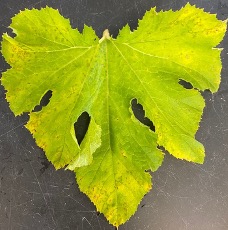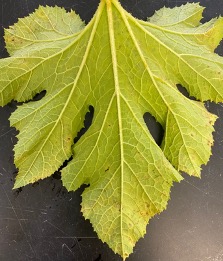Pumpkin Downy Mildew Found in Surry County, North Carolina
go.ncsu.edu/readext?725298
en Español / em Português
El inglés es el idioma de control de esta página. En la medida en que haya algún conflicto entre la traducción al inglés y la traducción, el inglés prevalece.
Al hacer clic en el enlace de traducción se activa un servicio de traducción gratuito para convertir la página al español. Al igual que con cualquier traducción por Internet, la conversión no es sensible al contexto y puede que no traduzca el texto en su significado original. NC State Extension no garantiza la exactitud del texto traducido. Por favor, tenga en cuenta que algunas aplicaciones y/o servicios pueden no funcionar como se espera cuando se traducen.
Português
Inglês é o idioma de controle desta página. Na medida que haja algum conflito entre o texto original em Inglês e a tradução, o Inglês prevalece.
Ao clicar no link de tradução, um serviço gratuito de tradução será ativado para converter a página para o Português. Como em qualquer tradução pela internet, a conversão não é sensivel ao contexto e pode não ocorrer a tradução para o significado orginal. O serviço de Extensão da Carolina do Norte (NC State Extension) não garante a exatidão do texto traduzido. Por favor, observe que algumas funções ou serviços podem não funcionar como esperado após a tradução.
English
English is the controlling language of this page. To the extent there is any conflict between the English text and the translation, English controls.
Clicking on the translation link activates a free translation service to convert the page to Spanish. As with any Internet translation, the conversion is not context-sensitive and may not translate the text to its original meaning. NC State Extension does not guarantee the accuracy of the translated text. Please note that some applications and/or services may not function as expected when translated.
Collapse ▲Written by Lina Quesada-Ocampo and Kimberly D’Arcangelo
Cucurbit downy mildew, caused by the oomycete pathogen Pseudoperonospora cubensis, has been confirmed on a pumpkin sample from a production field in Surry County on August 21, 2020. This is the first report of clade 1 P. cubensis isolates in North Carolina.
Small, circular chlorotic lesions on the upper surface of the leaves and gray sporulation on the underside were symptoms and signs observed of CDM in pumpkin (Figure 1). For confirmation, sporangia typical of P. cubensis were observed on the underside of the leaf using a dissecting microscope (Figure 2).

Figure 1: Circular, yellow lesions on surface of the leaves. (Kimberly D’Arcangelo, NC State Vegetable Pathology Lab)

Figure 2: Dark spores on the underside of the leaf (Kimberly D’Arcangelo, NC State Vegetable Pathology Lab)
Pseudoperonospora cubensis has two types of isolates or clades that preferentially infect certain cucurbit crops. In North Carolina, clade 2 isolates preferentially infect cucumbers and cantaloupes, while clade 1 isolates preferentially infect squash, pumpkin, and watermelon.
Growers of all cucurbits are recommended to take immediate action to protect their crops with effective fungicides in North Carolina.
As this pathogen becomes resistant to fungicides quickly, it is critical to have a robust spray program that alternates effective modes of action and tank mixes with protective chemistries to reduce the build-up of fungicide-resistant isolates. Results from our annual fungicide efficacy trials in North Carolina have revealed differences in fungicide efficacy between clade 2 and clade 1 P. cubensis isolates, thus, please refer to our cucurbit downy mildew fact sheet for effective chemistries for each isolate type depending on your cucurbit crop.
The recent rains in the state create favorable conditions for the pathogen and we expect more fields to become infected as the weather continues to be wet and cool. If you think you may have CDM in your fields, please contact your local Extension agent and send physical samples and/or photos to the Plant Disease and Insect Clinic. Upon confirmation, please make a completely anonymous report to the Cucurbit downy mildew IPM website.
Management of CDM remains a community effort because it is an airborne pathogen that can travel from state to state through wind currents. We encourage growers and homeowners to actively scout cucurbit leaves for downy mildew throughout the season.
Register with the CDM IPM PIPE to receive texts, emails and/or phone alerts when new disease outbreaks are reported near you.


